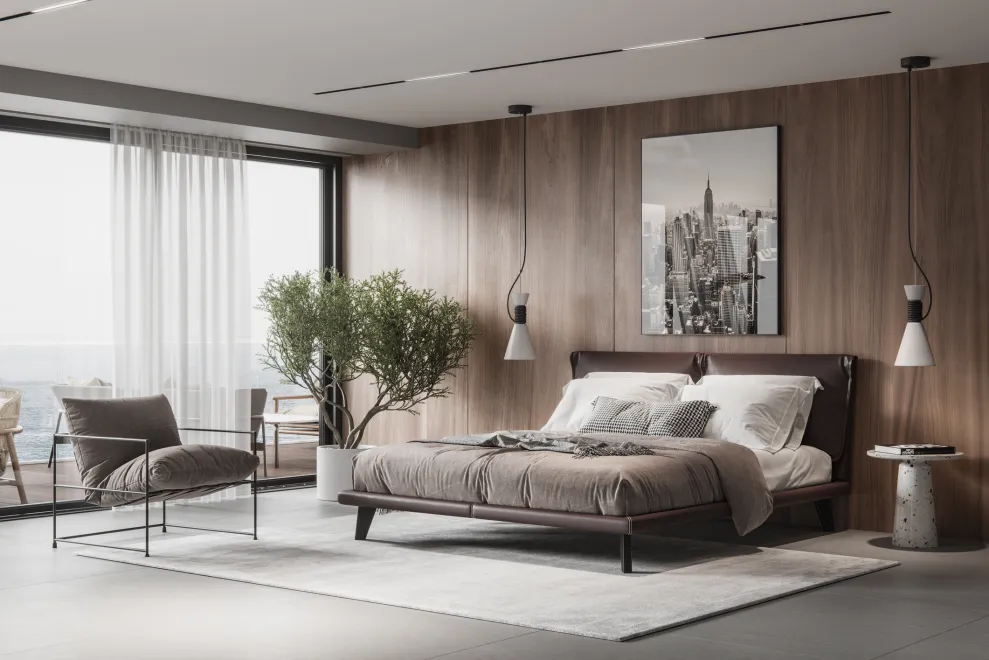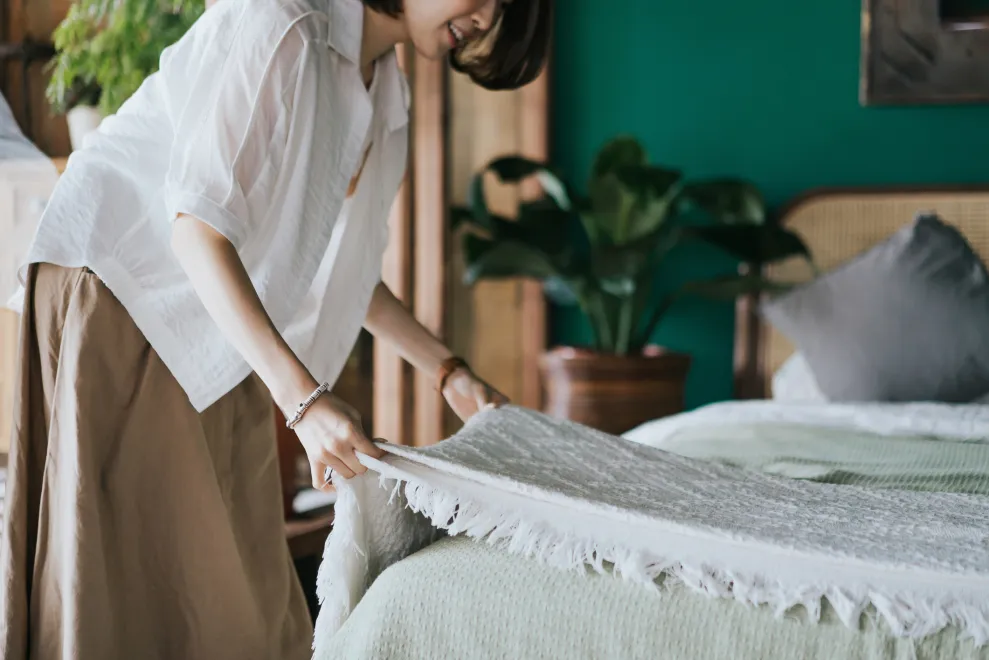In today’s fast-paced world, where our minds are constantly pulled in multiple directions, it’s no wonder more people are seeking peace and simplicity in their homes—especially in the bedroom. After all, your bedroom isn’t just a place to sleep. It’s your personal sanctuary, the one room in the house that should feel calm, grounded, and entirely yours.
That’s where minimalist design comes in. Minimalism isn’t about depriving yourself or living in an empty, colorless space. It’s about stripping away the unnecessary so that what’s left is meaningful, functional, and deeply relaxing. It’s about removing visual clutter and emotional noise so your bedroom can truly become a space for rest and renewal.
Think of a minimalist bedroom as a blank canvas—not lifeless, but full of potential. It doesn’t scream for your attention with bold prints or overstuffed furniture. Instead, it whispers comfort and order. It encourages mindfulness. And most importantly, it offers breathing room, both physically and mentally.
Minimalist bedrooms are also easier to maintain. With fewer items to clean, organize, and store, your room naturally stays tidier. It becomes less of a dumping ground for laundry or electronics and more of a personal retreat—a place where the outside world can’t intrude.
But creating a minimalist space doesn’t mean you have to sacrifice warmth or personality. In fact, some of the most inviting bedrooms use minimalist principles in clever, creative ways. It’s all about being intentional with your choices—from the color palette you use to the furniture you select, and even how you manage your belongings behind closed drawers.
In this article, we’ll walk you through six minimalist bedroom ideas that go beyond design trends. Each tip is crafted to help you create a space that looks serene and feels even better to be in. Plus, we’ll share strategies to help you maintain that serenity over time, so your bedroom continues to serve as a place of peace—day after day.
If you’ve ever walked into a room and felt instantly relaxed, you know the power of a well-designed space. Let’s help you create that same feeling in your own bedroom—with less stuff, more intention, and a whole lot more calm.
1. Choose Simple Décor Elements
The foundation of a minimalist bedroom starts with your décor. But don’t confuse “simple” with boring. The idea is to be intentional—every object should have meaning or a functional purpose. Start by choosing a soothing color palette. Neutral shades like white, beige, soft gray, or even earthy tones such as clay or sage green create a peaceful canvas. These hues don’t overstimulate the senses and serve as a backdrop that helps other elements shine.
Instead of crowding your walls with artwork, choose a single, striking piece that brings you joy. A large-scale photograph, a canvas with abstract art, or even a line drawing can set the tone without creating visual noise. Similarly, opt for a single vase with fresh greenery or a ceramic sculpture for your nightstand or dresser.
Don’t underestimate the power of texture in minimalist décor. Linen bedding, a wool throw, or a jute rug can add dimension without adding clutter. Consider natural materials like rattan, bamboo, or wood, which give the space an organic warmth that’s both soothing and stylish.
Above all, resist the urge to overfill shelves and surfaces. Negative space is a design element in itself—it gives the eye a place to rest and makes the room feel more open. With fewer distractions, you’ll be more likely to experience the sense of calm that a minimalist bedroom is meant to provide.
2. Opt for Sleek Furniture

When choosing furniture for your minimalist bedroom, think “function meets form.” The lines should be clean, the design unfussy, and the materials durable. A platform bed is often a go-to choice—it’s low, grounded, and inherently minimal. If possible, choose one with built-in drawers underneath. This extra storage means fewer furniture pieces are needed, leaving the room feeling spacious and uncluttered.
Nightstands should follow the same principle. Go for streamlined options with drawers to keep daily-use items tucked away. Open shelving can work, but it requires a high level of discipline to stay tidy—drawers are your best friend for a serene space.
Ditch the heavy, ornate dressers and instead opt for low-profile designs. Scandinavian furniture styles are a great source of inspiration, with their soft curves, wood tones, and minimalist silhouettes. Think tapered legs, matte finishes, and functionality that doesn’t sacrifice beauty.
Less is more. Rather than trying to fill every corner with furniture, pick only what’s essential. Ask yourself: “Do I need this to rest or recharge?” If the answer is no, it likely doesn’t belong in your minimalist bedroom. This philosophy doesn’t just apply to beds and dressers—it extends to seating, storage benches, and accent tables.
Quality over quantity also plays a role here. Fewer, well-crafted pieces will create a more polished and serene atmosphere than several cheaper, mismatched ones. Invest in timeless designs that you’ll love for years, not just trends that come and go.
3. Use Hidden Storage
One of the biggest obstacles to achieving a minimalist bedroom is clutter. But the good news? You don’t have to get rid of everything—you just need to store things smarter. That’s where hidden storage comes into play.
Start under the bed. Storage beds with built-in drawers or even slide-out boxes can hold seasonal clothing, extra bedding, or shoes. If your bed has legs, under-bed storage containers that match your room’s palette can be a discrete solution.
Look for nightstands with drawers instead of open cubbies. Not only does this keep your bedtime essentials tucked away, but it also helps maintain a clean, visual flow. Wall-mounted shelves with hidden compartments or headboards with built-in storage nooks can be equally effective.
Ottomans with hollow interiors, window seats with storage, and even mirrored wardrobes with deep shelving can all play double duty. These options let you stash items while keeping your surfaces and floor space clean.
Use matching baskets or fabric bins to hide away cords, electronics, or books. Stick to a limited color palette for these too—chaotic storage can still feel messy even if it’s technically “put away.”
Hidden storage doesn’t just free up space physically—it creates mental space as well. When everything has a place, you’re less likely to feel overwhelmed. The room begins to work for you, rather than against you, making relaxation and focus that much easier.
4. Be Smart About Lighting

Lighting can make or break the mood of any room, and in a minimalist bedroom, it’s even more critical. Minimalism is about serenity and simplicity, and the lighting should reflect that.
During the day, maximize natural light. Keep windows unobstructed by heavy drapes. Sheer curtains in neutral colors diffuse light beautifully, softening it while maintaining privacy. If your room doesn’t get much sunlight, consider reflective elements like mirrors to bounce light around and open up the space.
At night, switch to layered lighting. This means combining ambient lighting (like overhead ceiling fixtures) with task lighting (like bedside lamps) and accent lighting (like wall sconces or LED strips). Dimmer switches are a minimalist’s best friend because they give you full control over brightness and mood.
Choose warm white light bulbs over stark white or cool-toned ones. Warm lighting is easier on the eyes and creates a cozier atmosphere, especially at bedtime. Avoid harsh fluorescents or overly decorative lighting fixtures that clash with minimalist principles.
Lamps should be as functional as they are beautiful. Look for ones with a simple base, perhaps a matte or brushed finish, and a clean shade. Cord management also plays a part in visual tidiness—use clips or cord covers to keep things neat.
Smart bulbs or programmable lighting systems can enhance your routine by simulating sunrise in the morning or dimming automatically at night. This not only supports better sleep hygiene but also keeps your bedroom looking clean and modern.
5. Incorporate Color and Texture Strategically
A common misconception is that minimalist bedrooms must be entirely white and sterile. Not true. Minimalism thrives on balance, and subtle color and texture are essential tools for making a space feel cozy, not cold.
Stick with a mostly neutral base—think whites, creams, tans, and soft grays. Then, layer in muted accent colors like sage green, terracotta, navy, or dusty rose. These hues add warmth without overwhelming the space.
Textures are your secret weapon. Soft textiles like linen, wool, or cotton add comfort and richness. A waffle-knit throw blanket, a boucle chair, or even a chunky woven rug can all contribute depth without adding clutter.
Wall finishes matter, too. A matte painted wall offers a different feel than a high-gloss finish. A textured wallpaper or a raw plaster accent wall can introduce dimension while staying true to minimalist design.
Use texture and color to highlight focal points. A textured bedspread in a muted tone can become the room’s visual centerpiece. Or a single accent chair in a calming color can create contrast while still feeling serene.
The key is restraint. Don’t overload your space with too many colors or patterns. Stick to two or three textures and a limited palette to maintain the minimalist ethos. Every element should have a purpose—either functional or emotional—and work in harmony with the rest of the room.
6. Keep Surface and Floor Space Clear

One of the fastest ways to undo all your minimalist efforts is to let surfaces become landing pads for random objects. A clear floor and clean surfaces make a room feel larger, more peaceful, and more deliberate.
Let’s start with the floor. Only include furniture you truly need. If your space is small, consider mounting lights instead of using floor lamps. Choose floating nightstands or wall-mounted shelves to open up the visual space.
Avoid letting shoes, laundry baskets, or storage bins take over the floor. These should have designated storage places—whether in a closet or under the bed. Keep rugs simple in both pattern and color, allowing them to frame the room instead of dominating it.
For surfaces like dressers and nightstands, aim for near-zero clutter. A single lamp, a small bowl for jewelry, or a candle is usually enough. The more objects you place here, the less tranquil the room will feel. It’s okay to have a few personal touches—just don’t let them pile up.
Get into the habit of resetting your space daily. That might mean folding a throw blanket, putting books back on the shelf, or clearing yesterday’s coffee mug. It only takes a few minutes, but it keeps the environment consistently calm.
Finally, make cleaning part of your design. Surfaces that are easy to wipe down, floors that don’t trap dust, and clutter-free corners all make tidying up faster and less stressful.
How to Maintain a Minimalist Bedroom in the Long Run
Creating a minimalist bedroom is just the beginning. The real challenge is maintaining it. Life gets busy, habits shift, and clutter naturally builds up. But with a few simple routines, you can keep your bedroom serene and functional for years to come.
1. Practice Regular Decluttering
Schedule a 10-minute check-in every month. Look around your room and ask yourself what you’ve used, what brings you joy, and what feels unnecessary. Let go of items that no longer serve a purpose or match your current lifestyle.
2. Embrace Mindful Purchasing
Before buying anything new, pause. Ask yourself: “Do I really need this? Where will it go? Will it disrupt the space?” This prevents impulse purchases that lead to future clutter.
3. Create a Daily Reset Routine
Before bed, take a few minutes to return things to their place. Straighten pillows, put away clothing, and clear nightstand surfaces. These small actions reinforce the habit of cleanliness and keep the room serene.
4. Limit Décor Rotations
You don’t need to change your décor with every season. Instead, rely on a few timeless pieces you truly love. If you want to switch things up occasionally, keep a small box of alternate artwork or pillow covers that align with your color scheme.
5. Stay Flexible, Not Rigid
Minimalism is a mindset, not a strict rulebook. If you love a vibrant quilt or a bold piece of art, it can still belong in your space—just build the room around it intentionally. The goal is to create peace, not perfection.
By maintaining your minimalist space with these mindful habits, your bedroom will continue to be a calm retreat where rest, clarity, and comfort come naturally




